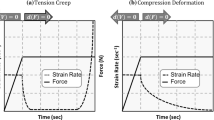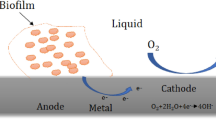Abstract
Chronoamperometry (CA), phase space reconstruction, correlation dimension, multifractal detrended fluctuation analysis (MFDFA) combining linear sweep voltammetry (LSV), electrochemical impedance spectroscopy (EIS), and surface morphology observation were used to systematically analyze the nonlinear dynamics behavior of electrochemical dissolution of Ti-48Al-2Cr-2Nb alloy at high applied potentials. The relationships of applied potential E with nonlinear dynamic characteristic (saturation correlation dimension \(D_2^{\prime}\), Hurst exponent H, the area of the spectrum S) and electrochemical corrosion parameters (capacitance ratio (Ca/Cb)) were analyzed, respectively. The results show that non-uniform corrosion at low potentials (7–13 V) results in rough surfaces; a higher potential (16 V) contributes to obtaining smoother surface. The growth of saturated correlation dimension reveals that the corrosion behavior of Ti-48Al-2Cr-2Nb alloy changes from non-uniform corrosion to uniform corrosion. The number of major variables in the electrochemical system is 6 for 7–13 V and is 7 for 16 V. The inversely proportional relationships of the area of the spectrum S and Hurst exponent H between the applied potential, respectively, testify that high potential is favorable for uniform corrosion of Ti-48Al-2Cr-2Nb alloy.










Similar content being viewed by others
References
Burtscher M, Klein T, Lindemann J, Lehmann O, Fellmann H, Güther V, Clemens H, Mayer S (2020) An advanced TiAl alloy for high-performance racing applications. Materials 13(21):4720. https://doi.org/10.3390/ma13214720
Neelam NS, Banumathy S, Nageswara Rao GVS, Bhattacharjee A (2021) Study of microstructure and mechanical properties of Γ-Ti-46.5Al-2Cr-(3.5 & 5.0) Nb alloys. Mater Today 41:1069–1072. https://doi.org/10.1016/j.matpr.2020.07.131
Xu Z, Wang Y (2021) Electrochemical machining of complex components of aero-engines: developments, trends, and technological advances. Chinese J Aeronaut 34:28–53. https://doi.org/10.1016/j.cja.2019.09.016
Cakmak E, Nandwana P, Shin D, Yamamoto Y, Gussev MN, Sen I, Seren MH, Watkins TR, Haynes JA (2019) A comprehensive study on the fabrication and characterization of Ti-48Al-2Cr-2Nb preforms manufactured using electron beam melting. Materialia 6. https://doi.org/10.1016/j.mtla.2019.100284
Zhang Y, Lee YJ, Chang S, Chen Y, Bai Y, Zhang J, Wang H (2022) Microstructural modulation of TiAl alloys for controlling ultra-precision machinability. Int J Mach Tool Manu 174 :103851. https://doi.org/10.1016/j.ijmachtools.2022.103851
Feng R, Shao Z, Yang S, Cao H, Li H, Lei C, Zhang J (2022) Material removal behavior of nanoscale shear cutting and extrusion cutting of monocrystalline γ-TiAl alloy. Int J Adv Manuf Technol 119(9):6729–6742. https://doi.org/10.1007/s00170-021-08536-8
Wang Y, Xu Z, Zhang A (2020) Anodic characteristics and electrochemical machining of two typical γ-TiAl alloys and its quantitative dissolution model in NaNO3 solution. Electrochim Acta 331:135429. https://doi.org/10.1016/j.electacta.2019.135429
Wang J, Xu Z, Wang J, Zhu D (2021) Anodic dissolution characteristics of Inconel 718 in C6H5K3O7 and NaNO3 solutions by pulse electrochemical machining. Corros Sci 183: 109335. https://doi.org/10.1016/j.corsci.2021.109335
Clifton D, Mount A, Jardine DJ, Roth R (2001) Electrochemical machining of gamma titanium aluminide intermetallics. J Mater Process Technol 108:338–348. https://doi.org/10.1016/S0924-0136(00)00739-1
Liu W, Ao S, Li Y, Liu Z, Zhang H, Manladan SM, Luo Z, Wang Z (2017) Effect of anodic behavior on electrochemical machining of Tb6 titanium alloy. Electrochim Acta 233:190–200. https://doi.org/10.1016/j.electacta.2017.03.025
Malouche MM, Stein N, Lecomte J, Boulanger C, Rancic M (2020) Influence of the electrolyte composition on the electrochemical dissolution behavior of forged Inconel 718. J Appl Electrochem 50(2):197–206. https://doi.org/10.1007/s10800-019-01386-z
Wang Y, Xu Z, Zhang A (2019) Electrochemical dissolution behavior of Ti-45al-2mn-2nb+0.8 Vol% Tib2 Xd alloy in NaCl and NaNO3 solutions. Corros Sci 157:357–369. https://doi.org/10.1016/j.corsci.2019.06.010
Wang Y, Xu Z, Zhang A, Xu G, Zhang C (2021) Surface morphology and electrochemical behaviour of Ti-48Al-2Cr-2Nb alloy in low-concentration salt solution. Sci China Technol Sci 64(2):283–296. https://doi.org/10.1007/s11431-019-1558-8
Wang Y, Xu Z, Zhang A (2019) Comparison of the electrochemical dissolution behavior of extruded and casted Ti-48Al-2Cr-2Nb alloys in NaNO3 solution. J Electrochem Sci 166(12):E347–E357. https://doi.org/10.1149/2.0501912jes
He B, Wang D, Zhang J, Lei W (2022) Investigation of electrochemical dissolution behavior of near-α Ta15 titanium alloy in NaCl solution with low-frequency pulse current. J Electrochem Soc 169(4): 043515. https://doi.org/10.1149/1945-7111/ac669d
Wang H, Liu J, Gu D, Zhu D (2020) Electrochemical dissolution behavior of Ti-48Al-2Cr-2Nb in NaNO3 and NaCl electrolytes. Int J Electrochem Sci 15(9):9313–9324. https://doi.org/10.20964/2020.09.70
Liao CJ, Liu Q, Ma XZ, Liu JH (2019) Relationship between surface heterogeneity and electrochemical interface behavior of the TiAl alloy electrode. J Phys Chem C 123(1):473–484. https://doi.org/10.1021/acs.jpcc.8b09123
Liao CJ, Zhang XM, Luo ZJ (2022) Magnetic field effects on electrochemical dissolution behavior and surface quality of electrochemical machining of Ti-48Al-2Cr-2Nb alloy. J Appl Electrochem. https://doi.org/10.1007/s10800-022-01756-0
Weinmann M, Stolpe M, Weber O, Busch R, Natter H (2015) Electrochemical dissolution behaviour of Ti90Al6v4 and Ti60Al40 used for ECM applications. J Solid State Electr 19(2):485–495. https://doi.org/10.1007/s10008-014-2621-x
Hudson JL, Bassett MR (1991) Oscillatory electrodissolution of metals. Rev Chem Eng 7(2):109–170. https://doi.org/10.1515/revce-1991-070201
Hudson JL, Tsotsis TT (1994) Electrochemical reaction dynamics: a review. Chem Eng Sci 49(10):1493–1572. https://doi.org/10.1016/0009-2509(94)85063-1
Baroux B, Mayet H, Gorse D (1996) Chaotic behaviors in pitting corrosion processes 97(7):461–471. https://doi.org/10.13140/2.1.4394.2087
Hudson JL (1993) Chaos in electrochemical systems. In Chaos in Chemistry and Biochemistry. World Scientific. https://doi.org/10.1142/9789814354745_0005
dos Santos CGP, Machado EG, Kiss IZ, Nagao R (2019) Investigation of the oscillatory electrodissolution of the nickel-iron alloy. J Phys Chem C 123(39):24087–24094. https://doi.org/10.1021/acs.jpcc.9b06423
Spanoudaki D, Kaimi A, Kouzi L, Sazou D (2018) Analysis of the temporal self-organizational phenomena observed during the electrodissolution of Zn in sulfuric acid solutions. Mater Today 5(14, Part 1):27626–27635. https://doi.org/10.1016/j.matpr.2018.09.083
Wang Y, Xu Z, Zhang A (2019) Comparison of the electrochemical dissolution behavior of extruded and casted Ti-48Al-2Cr-2Nb alloys in NaNO3 solution. J Electrochem Soc 166:E347–E357. https://doi.org/10.1149/2.0501912jes
Kiss IZ, Zhai Y, Hudson JL (2002) Emerging coherence in a population of chemical oscillators. Science 296(5573):1676–1678. https://doi.org/10.1126/science.1070757
Eschenazi EV, Tsega Y, Ballard N, Glass G (1995) Electrochemical oscillations, surface morphology and corrosion of selected thermal sprayed alloys. MRS Proc 407:365. https://doi.org/10.1557/PROC-407-365
Ge X, Dietz MS, Alexander NA, Kashani MM (2020) Nonlinear Dynamic behaviour of severely corroded reinforced concrete columns: shaking table study. B Earthq Eng 18(4):1417–1443. https://doi.org/10.1007/s10518-019-00749-3
Legat A, Doleček V (1995) Chaotic analysis of electrochemical noise measured on stainless steel. J Electrochem Soc 142(6):1851–1858. https://doi.org/10.1149/1.2044205
Xia D, Song S, Wang J, Shi J, Bi H, Gao Z (2012) Determination of corrosion types from electrochemical noise by phase space reconstruction theory. Electrochem Commun 15(1):88–92. https://doi.org/10.1016/j.elecom.2011.11.032
Martemianov S, Thomas A, Adiutantov N, Denisov E, Evdokimov Y, Hissel D (2020) Electrochemical noise analysis of a PEM fuel cell stack under long-time operation: noise signature in the frequency domain. J Solid State Electr 24(11):3059–3071. https://doi.org/10.1007/s10008-020-04759-z
López J, Contreras J (2013) Performance of multifractal detrended fluctuation analysis on short time series. Phys Rev 87: 022918. https://doi.org/10.1103/PhysRevE.87.022918
Ihlen E (2012) Introduction to multifractal detrended fluctuation analysis in MATLAB. Front Physiol 3:141. https://doi.org/10.3389/fphys.2012.00141
Buteau S, Dahn D, Dahn J (2018) Explicit conversion between different equivalent circuit models for electrochemical impedance analysis of lithium-ion cells. J Electrochem Soc 165:A228–A234. https://doi.org/10.1149/2.0841802jes
Dragomiretskiy K, Zosso D (2014) Variational mode decomposition. IEEE Trans Signal Process 62(3):531–544. https://doi.org/10.1109/TSP.2013.2288675
Liu Y, Yang G, Li M, Yin H (2016) Variational mode decomposition denoising combined the detrended fluctuation analysis. Signal Process 125(C):349–364. https://doi.org/10.1016/j.sigpro.2016.02.011
Fletcher SBVJ, Kirkpatrick I (2014) A universal equivalent circuit for carbon-based supercapacitors. J Solid State Electr 18(5):1377–1387. https://doi.org/10.1007/s10008-013-2328-4
Aladjem A (1973) Anodic oxidation of titanium and its alloys. J Mater Sci 8(5):688–704. https://doi.org/10.1007/BF00561225
Takens F (1981) Detecting strange attractors in turbulence, in: D Rand, L-S Young (Eds.) Dynamical systems and turbulence. Warwick 1980, Springer Berlin Heidelberg, Berlin, Heidelberg
Bakker R, Schouten JC, Coppens MO, Takens F, Bleek C (2000) Chaotic attractor learning and how to deal with nonlinear singularities, Proceedings of the IEEE 2000 Adaptive Systems for Signal Processing, Communications, and Control Symposium (Cat. No.00EX373) 466–470
Aldrich C, Qi BC, Botha PJ (2006) Analysis of electrochemical noise data with phase space methods. Miner Eng 19(14):1402–1409. https://doi.org/10.1016/j.mineng.2006.01.008
Strozzi F, Zaldivar J (2002). Embedding theory: introduction and applications to time series analysis. https://doi.org/10.1007/978-1-4615-0931-8_2
Grassberger P, Procaccia I (2004) Measuring the strangeness of strange attractors, in: BR Hunt, T-Y Li, JA Kennedy, HE Nusse (Eds.). The theory of chaotic attractors, Springer New York, New York. https://doi.org/10.1007/978-0-387-21830-4_12
Ramírez-Platas M, Morales-Cabrera MA, Rivera VM, Morales-Zarate E, Hernandez-Martinez E (2021) Fractal and multifractal analysis of electrochemical noise to corrosion evaluation in A36 steel and AISI 304 stainless steel exposed to MEA-Co2 aqueous solutions. Chaos Soliton Fract 145 110802. https://doi.org/10.1016/j.chaos.2021.110802
Ashassi-Sorkhabi H, Seifzadeh D, Hosseini MG (2008) EN, EIS and Polarization studies to evaluate the inhibition effect of 3h-phenothiazin-3-one, 7-dimethylamin on mild steel corrosion in 1m HCl solution. Corros Sci 50(12):3363–3370. https://doi.org/10.1016/j.corsci.2008.09.022
Wang G, Ren X-m, Li L, Wang Z-Z (2007) Multifractal analysis of surface EMG signals for assessing muscle fatigue during static contractions. J Zhejiang Univ-Sc A 8(6):910–915. https://doi.org/10.1631/jzus.2007.A0910
Movahed MS, Jafari GR, Ghasemi F, Rahvar S (2006) Tabar MRR (2006) Multifractal detrended fluctuation analysis of sunspot time series. J Stat Mech-Theory E 02:P02003–P02003. https://doi.org/10.1088/1742-5468/2006/02/p02003
Kantelhardt JW, Zschiegner SA, Koscielny-Bunde E, Havlin S, Bunde A, Stanley HE (2002) Multifractal detrended fluctuation analysis of nonstationary time series. Physica A 316(1):87–114. https://doi.org/10.1016/S0378-4371(02)01383-3
Muzy JF, Baïle R, Bacry E (2013) Random cascade model in the limit of infinite integral scale as the exponential of a non-stationary 1/f noise. Application to Volatility Fluctuations in Stock Markets. Phys Rev E 87(4):042813. https://doi.org/10.1103/PhysRevE.87.042813
Lana X, Rodríguez-Solà R, Martínez MD, Casas-Castillo MC, Serra C, Kirchner R (2020) Multifractal structure of the monthly rainfall regime in Catalonia (NE Spain): evaluation of the non-linear structural complexity. Chaos 30(7): 073117. https://doi.org/10.1063/5.0010342
Wang J, Ning X, Chen Y (2003) Multifractal analysis of electronic cardiogram taken from healthy and unhealthy adult subjects. Physica A 323:561–568. https://doi.org/10.1016/S0378-4371(03)00045-1
Funding
This work was supported by the National Natural Science Foundation of China (grant numbers 22072040) and the Natural Science Foundation of Hunan Province (grant number 2020JJ4271).
Author information
Authors and Affiliations
Corresponding author
Ethics declarations
Conflict of interest
The authors declare no competing interests.
Additional information
Publisher's Note
Springer Nature remains neutral with regard to jurisdictional claims in published maps and institutional affiliations.
Rights and permissions
Springer Nature or its licensor (e.g. a society or other partner) holds exclusive rights to this article under a publishing agreement with the author(s) or other rightsholder(s); author self-archiving of the accepted manuscript version of this article is solely governed by the terms of such publishing agreement and applicable law.
About this article
Cite this article
Zhang, X., Luo, Z. & Liao, C. Nonlinear dynamic behaviors of electrochemical corrosion of Ti-48Al-2Cr-2Nb alloy at high applied potentials. J Solid State Electrochem 27, 417–426 (2023). https://doi.org/10.1007/s10008-022-05337-1
Received:
Revised:
Accepted:
Published:
Issue Date:
DOI: https://doi.org/10.1007/s10008-022-05337-1




